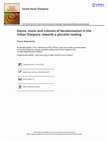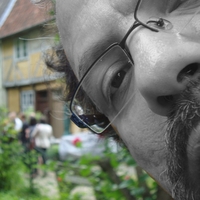Papers by Tina K. Ramnarine
Routledge eBooks, Nov 2, 2020
Routledge eBooks, May 26, 2020
-8-Music in The Diasporic Imagination and the Performance of Cultural (Displacement in TrinidadTi... more -8-Music in The Diasporic Imagination and the Performance of Cultural (Displacement in TrinidadTina K. Ramnarine ... The Roaring Lion (Rafael De Leon) and Atilla the Hun (Raymond Quevedo) sang about the reception they received from influential American musicians like the ...
Routledge eBooks, Oct 18, 2013
1. Musical Performance in the Diaspora: introduction. 2. Adieu Madras, Adieu Foulard: Musical Ori... more 1. Musical Performance in the Diaspora: introduction. 2. Adieu Madras, Adieu Foulard: Musical Origins and the Doudou's Colonial Pliant. 3. 'I take my dombra and sing to remember my homeland': identity, landscape and music in Kazakh communities of Western Mongolia. 4. "Happy Diwali!" Performance, multicultural soundscapes and intervention in Aotearoa/New Zealand. 5. Diasporic transpositions: indigenous and Jewish performances of mourning in twentieth-century Australia. 6. The Danza de las Canas: Music, Theatre and Afroperuvian Modernity

Ethnomusicology Forum, Dec 1, 2011
This article explores the symphony orchestra's potential to contribute to the making of civil... more This article explores the symphony orchestra's potential to contribute to the making of civil society. It highlights orchestral attempts to reach new communities through repertoire choices, outreach projects, interactive digital technologies, and initiatives addressing poverty and environmentalism. Metaphors of the ‘orchestra as society’, which have been shaped by notions of social relations, are outlined to provide a platform for considering the institution as a social agent in the contemporary world. The social conscience of symphony orchestras is illustrated with ethnographic case studies mainly from the British context: the City of Birmingham Symphony Orchestra's tribute concerts for the qawwali singer Nusrat Fateh Ali Khan and the ‘Rafi Resurrected’ recordings, the London Symphony Orchestra Gamelan community project and the Philharmonia Orchestra's digital project, ‘Re-Rite’. Orchestral advocacy and the quest for contemporary social relevance stand in contrast to pessimistic views in the late twentieth century on the future of the orchestra as a musical institution. Key concerns are the symphony orchestra as a socio-political actor, orchestral interaction as a mode of civic collaboration and orchestral participatory projects.
British journal of ethnomusicology, 1996
... Also, since the 1940s several dancers from Indiaincluding Rajkumar Krishna Persad, Sat and M... more ... Also, since the 1940s several dancers from Indiaincluding Rajkumar Krishna Persad, Sat and Mondira Balkaransingh, and Pratap and Priya Pawarhave held ... waist] I'll give you a modernjupa [wooden house] down in Penal and Til change my name to Rooplal or Sparrowlal I ...

Oxford University Press eBooks, Jun 18, 2020
This chapter reflects on the legacies of Sibelius’s Violin Concerto in D Minor (op. 47), noting t... more This chapter reflects on the legacies of Sibelius’s Violin Concerto in D Minor (op. 47), noting the establishment of the Sibelius Violin Competition and listing violin concertos composed by Finnish composers after Sibelius. It discusses concerto writing as an exploration of the relationship between soloist and orchestra. By situating virtuosity as a trope in relational thought within philosophical discourses on human tendencies, this chapter argues that a politics of possibility emerges because the element of risk in a virtuoso’s performance is haunted by a moral drama played out on public stages with uncertain outcomes. This chapter, and the book as a whole, ends by moving away from a political view of the concerto to the question of how performing traditions are formed over time. The chapter concludes with a reading of the Sibelius violin concerto within the long ecological histories of musical transmission.
Bloomsbury Encyclopedia of Popular Music of the World, 2014
Routledge eBooks, Sep 22, 2017

Oxford University Press eBooks, Jun 18, 2020
This chapter argues that an appreciation of both regional and transnational violin-playing styles... more This chapter argues that an appreciation of both regional and transnational violin-playing styles is needed for a profound understanding of the Sibelius violin concerto. Sibelius’s musical ideas and performers’ interpretations of the violin concerto are shaped by different violin-playing traditions. This argument also offers perspectives on how pedagogy shapes musical transmission and performance style by focusing on Leopold Auer’s influence on the violin playing of the twentieth century. Leading into the main concerns of the fifth chapter, the argument concludes by noting that Auer’s teaching practice coincided with women’s emerging political voices. He accepted many women violinists into his class in the St. Petersburg Conservatory, women who went on to forge careers as virtuoso violinists and to champion Sibelius’s violin concerto internationally.

Jean Sibelius's Violin Concerto
This chapter reflects on the legacies of Sibelius’s Violin Concerto in D Minor (op. 47), noting t... more This chapter reflects on the legacies of Sibelius’s Violin Concerto in D Minor (op. 47), noting the establishment of the Sibelius Violin Competition and listing violin concertos composed by Finnish composers after Sibelius. It discusses concerto writing as an exploration of the relationship between soloist and orchestra. By situating virtuosity as a trope in relational thought within philosophical discourses on human tendencies, this chapter argues that a politics of possibility emerges because the element of risk in a virtuoso’s performance is haunted by a moral drama played out on public stages with uncertain outcomes. This chapter, and the book as a whole, ends by moving away from a political view of the concerto to the question of how performing traditions are formed over time. The chapter concludes with a reading of the Sibelius violin concerto within the long ecological histories of musical transmission.
Berghahn Books, Feb 1, 2004
... She is an ethnomusicology student whose own performance experience has been largely in ... Un... more ... She is an ethnomusicology student whose own performance experience has been largely in ... Undertaking fieldwork for undergraduate projects is an option available to anthropology as ...Ethnomusicology: Performance and Learning 239 account:'the scheduling of" fieldwork" in ...

Oxford University Press eBooks, Jun 18, 2020
This book highlights the unique insights that Jean Sibelius’s Violin Concerto in D Minor (op. 47)... more This book highlights the unique insights that Jean Sibelius’s Violin Concerto in D Minor (op. 47) offers into the composer’s musical imagination, violin virtuosity, and connections between violin-playing traditions. It discusses the concerto’s cultural contexts, performers who are connected with its early history, and recordings of the work. Beginning with Sibelius’s early training as a violinist and his aspirations to be a virtuoso player, the book traces the composition of the concerto at a dramatic political moment in Finnish history. This concerto was composed when Finland, as an autonomous Grand Duchy within the Russian Empire, was going through a period of intense struggle for self-determination and protest against Russian imperial policies. Taking the concerto’s historical context into consideration leads to a new paradigm of the twentieth-century virtuoso as a political figure, which replaces nineteenth-century representations of the virtuoso as a magical figure. The book explores this paradigm by analyzing twentieth-century violin virtuosity in terms of labor, recording technology, and gender politics, especially the new possibilities for women aiming to develop musical careers. Ultimately, the book moves away from the compositional context of the concerto and a reading of the virtuoso as a political figure to reveal how Sibelius’s musical imagination prompts thinking about the long ecological histories of musical transmission and virtuosity.

Oxford University Press eBooks, Jun 18, 2020
Records are instrumental in analyzing the history of performing traditions from the twentieth cen... more Records are instrumental in analyzing the history of performing traditions from the twentieth century onward and they have implications for theorizing virtuosity. There is a rich archive facilitating the comparison of different recorded interpretations of Sibelius’s Violin Concerto in D Minor (op. 47). This chapter discusses select recorded examples of Sibelius’s violin concerto beginning with Jascha Heifetz’s 1935 recording, which is a key moment in the history of this work. It then turns to examples of particular historical interest by Anja Ignatius, Ida Haendel, and Haimo Haitto. Key topics include musical biography, the child prodigy, and women virtuosos carving out a new vista of gender equality in the twentieth century. The discussion highlights issues around interpretation that inform listening to recordings and studying the concerto as a performer.
Oxford University Press eBooks, Jun 18, 2020
This chapter presents an overview of Sibelius’s early musical training, especially as a violinist... more This chapter presents an overview of Sibelius’s early musical training, especially as a violinist. It highlights the life-long persistence of Sibelius’s violin training in his musical imagination. It introduces key questions that are pursued throughout the book: What is the labor of virtuosity? How are performing traditions formed over time? What are the cross-genre musical influences in Sibelius’s violin concerto? The discussion in this chapter unfolds in relation to philosophical discourses on beauty and statehood, as well as on the idea of the virtuoso’s political potential, which builds on nineteenth-century views on the redemptive potential of civic action and on military-heroic symbolism in performance.
Oxford University Press eBooks, Jun 18, 2020
This chapter discusses Sibelius’s compositional processes in relation to his Violin Concerto in D... more This chapter discusses Sibelius’s compositional processes in relation to his Violin Concerto in D Minor (op. 47). It considers concerto models, Sibelius’s study of folk traditions, and the composer’s revision process. It argues that compositional processes are shaped by performers, performance environments, cross-genre interests, and critics, as well as by the composer’s imagination. This chapter highlights violinists such as Wilhelm Burmester, alongside critics, especially Karl Flodin, who are part of the concerto’s compositional and revision history. The chapter also outlines the main structural and melodic features of the revised concerto.
Preservation, digital technology & culture, Dec 19, 2018
This article takes it point of departure from conversations with Gumbula that centred on the tran... more This article takes it point of departure from conversations with Gumbula that centred on the transmission of tradition and British imperial histories. It focuses on examples from India and its diaspora, discussing the mantra, in particular. This is a traditional genre evoking cultural and spiritual heritages, but it is also connected with cyber technologies. The discussion concludes with observations on post-national thinking and predictions from physicists on the future of humanity as a multiplanet species.
Interventions: International Journal of Postcolonial Studies, Jun 1, 2013
This essay explores ‘indigenous’ and ‘western’ forms of the sacred through the case of the Sámi i... more This essay explores ‘indigenous’ and ‘western’ forms of the sacred through the case of the Sámi in the northern fringes of Europe. The focus is on sonic images, ritual performance, shamanic drum practice and animal symbolism in the film Ofelaš (Pathfinder 1987). The essay explores how this film represents and affirms indigenous sacrality, reinscribes the dualities of indigenous–western and reifies ethnic politics in the northernmost regions of modern Nordic nation-states. Ultimately, the exploration moves beyond the micro-dynamics of polar politics to look at the film's wider relevance. In privileging sonic expression and its spectres, I read the film as contributing to critical perspectives on authority, knowledge, history, oral tradition and climate change in postcolonial thinking.

South Asian Diaspora, Jan 18, 2019
Decolonisation is a creative process, as well as a historical and political one. This article out... more Decolonisation is a creative process, as well as a historical and political one. This article outlines key issues in researching the creative processes of decolonisation with reference to dance and music in the Indian Diaspora. It begins with Gandhi's 'experiments with truth', which first developed a political reach in the context of Indian indenture within the British Empire but left a fractured legacy in the decolonising era. Their conceptual import frames a discussion on participatory research, dialogic pedagogies and intellectual responsibility. The notion of dialogue contextualises examples of musical collaborations, as well as intellectual exchanges between Gandhi and two of his interlocutors: Ambedkar and Tolstoy. These shift discussion from an oppositional narrative of decolonisation towards more complex views of cultural and intellectual interactions in decolonising processes. The final section introduces the volume's case studies, which collectively encourage a pluralist reading of dance and music in the cultures of decolonisation.











Uploads
Papers by Tina K. Ramnarine